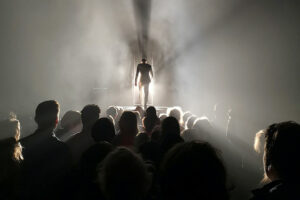Nature’s bridge to 21st century education

Anew age of leadership is upon us — starting from the 9/11 World Trade Center bombing, the global financial crisis of 2009, the COVID pandemic, to the networked disinformation amidst the looming geo-political and economic divides — confronting every human with great uncertainty. (Not to speak of Nature’s own reminder — that climate change and earthquakes are still part of our reality.)
Not all people can solve those existential problems — but educating humans to be closer to each other as humans is a step forward, by bridging divides of age, race, organization, nations, and positions to make sense of a chaotic world.
SWARM LEADERSHIPThus, we see the rise of the responsive leader who “connects everyone to collaborate so we learn from each other in quickly adapting to fast-changing situations” — rather than those who are plainly relational by engaging the follower with his/her own skills and traits, or the directive leader who shows his/her own way. Nor the charismatic one who asks others to gaze at a person to inspire them.
These are labels, respectively, of Leadership 4.0, 3.0, 2.0, and 1.0. by Richard Kelly in his book Swarm Leadership and the Fourth Industrial Revolution (Palgrave: 2019).
Leadership 4.0 sees leaders as part of a swarm: a leader who connects others, as in a swarm of locusts, bees, termites, and ants that find themselves in self-organizing communities; wired across cultures, disciplines, and fields; agile, thanks to networked intelligence. A leader who rethinks power as “achievable through people rather than over people” (Peter Miller, Smart Swarm, 2010). One who harnesses the networks of its own members, and thus sees their organization as a network of networks, not fearful of doing everything by oneself.
No organization, not even one that represents the elite of any group by any metric — political parties, economic groups, social clubs, or technological entities — will survive the 21st century without loosening organizational hierarchies. The V formation of flying geese has no single leader; when one is up front, one has to work the hardest because of wind resistance.
REFORMING EDUCATIONOne of the “new” issues that has attracted enterprise leaders of the country is the mismatch between what industry needs and what schools offer. Rather than line up for a job, college graduates are admonished to create them to help solve the country’s endemic underemployment and severe unemployment problems. Many bright ones vote with their feet for greener pastures elsewhere.
Is the trifocal structure of Philippine education the problem? Or is that merely a manifestation of the deep underlying cultural legacy of geography — an archipelagic mindset, amidst water in the ring of fire, and a Latin feudal economy in burgeoning Asia?
Can education leaders and reformers learn from Nature? Can we be connected even as we are geographically divided?
Vision/mission statements abound. Commitments, abilities, and willingness however do not come in the same proportions, heavily weighted towards promises until deaths do the parting.
Why not study a collective scenario of doomsday, or how to forestall it? Huddled polar bears in freezing Arctic weather take turns moving inwards around a circle — in a slow dance to redistribute warmth within a group. Will the old and nouveau riche of the country be able to do the same for the poor amidst them? Some cynics will say, “but we are in the global warming stage!”
THE DARK SIDE OF CROWDS…The dark side of crowds is how Peter Miller (Smart Swarm: Using Animal Behavior to Change our World, Collins: 2010) saw the Feb. 4, 2006 stampede in the PhilSports Arena. Wowowee, the popular television game show, was taping for its first anniversary program. It lured crowds of over 30,000 people to the stadium with a capacity for only about 17,000 — on promises of minibuses, a home, and a million-peso jackpot.
Even before the gates opened, Miller narrates how the crowd of “hungry and sleepless” people scrambled, upon hearing a spokesperson allegedly announce “that only the first 300 people with tickets would be eligible to compete for the million-peso prize.” As “hope and dreams of getting rich would vanish” if they would not be among the first to enter the stadium, people pushed from the back, caused a barricade to collapse, and unnerving the guards who instinctively closed the gate.
People behind, unaware of what was transpiring, ended up in a frenzy as an energized throng. The surging crowd and the steep incline toward the gate resulted in the crushing death of 74 people, mostly older women, and hundreds injured.
Miller notes two guides for preventing tragedies: restraining crowd behavior through information for “individuals to maintain personal control,” and keeping people density below critical levels. These are as useful for any structure, or even in urban planning and population programs. He adds how healthy markets likewise require information. “When investors give up personal judgment in favor of following a crowd’s whim, they disconnect a market from critical information.”
… AND THE WISDOM OF “SMART GROUPS”Thus, working with others in “smart groups” is Miller’s first lesson from swarms in nature. Taking the cue from biology, he notes that the resilience and flexibility of swarms, flocks, herds, colonies, and schools result from how interaction is managed. Hence, education systems can focus on how to reduce the VUCA (Volatile, Uncertain, Complex and Ambiguous) aspects of 21st century life through problem-solving groups, as in small learning teams in the case study approach, or huge ones like those who contribute to Wikipedia.
What determines the size of “smart groups”? Both the magnitude of the problem and the way groups are structured. In the case of a more massive challenge, e.g., in reforming the learning skills and competencies in general or teacher education in the Philippines, a solution is combining liberal arts with science (or STEM courses) — the same prescription that Albert Einstein promoted for learning in the last millennium.
The mechanisms to manage interactions include 1.) local knowledge with a diversity of information, 2.) heuristics or rules of thumb to minimize computational requirements, 3.) repeated interaction within teams and “quorum thresholds” for wiser decisions, and, 4.) “a healthy dose of randomness in individual behaviors.”
Miller’s second lesson from smart swarms is for individuals to bring ideas to the table in their true authentic selves, not blindly copying others, ready to agree or disagree, competing as well as cooperating (co-opetition). He concludes, “the best way to serve the group, it turns out, is to be true to ourselves.”
All these are from animal behavior with which humans can instinctually change the world.
This article reflects the personal opinion of the author and does not reflect the official stand of the Management Association of the Philippines or MAP.
Federico “Poch” M. Macaranas, PhD, is the chairman of the MAP Education Committee. He is a retired full professor and an adjunct faculty at the Asian Institute of Management.




